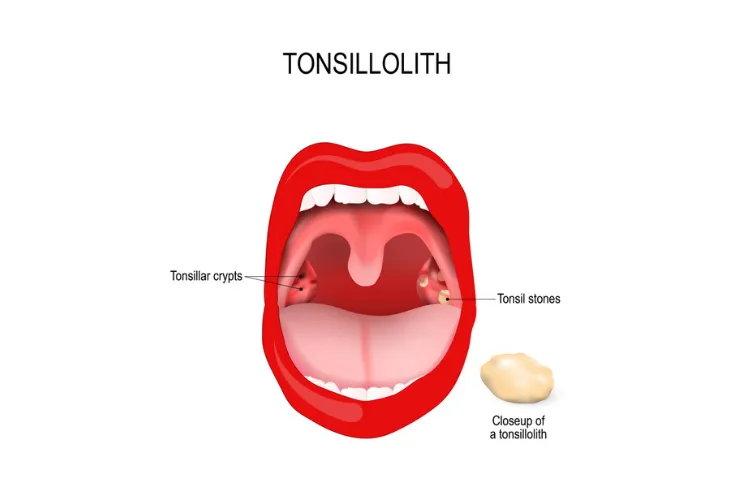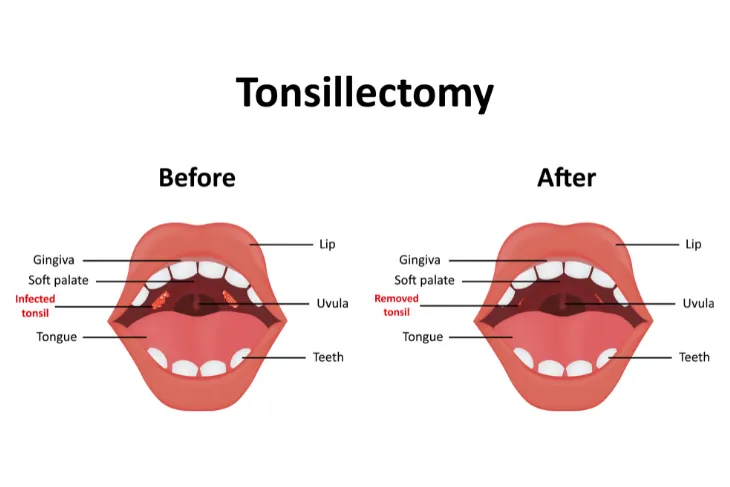It’s easy to forget how complex the inner workings of your mouth truly are. You enjoy your lunch, you sip your tea, and you brush your teeth every single day, and rarely give it any thought. That is until pain, soreness, and irritation come knocking. Your tonsils are often overlooked too, up until the moment that there’s something wrong with them.
One of the few things that may cause you to curse out your tonsils is known as tonsil stones. But what are they, what causes them, what are their symptoms and what can you do to get rid of them? Read along and find out!
What Are Tonsil Stones?
Tonsil stones aren’t always easy to spot and can vary wildly in shape and size. But what exactly are they?
The back section of the average human throat features a pair of soft tissue masses called tonsils. Part of what’s known as the lymphatic system, tonsils are usually called on to help trap bacteria and viruses that enter your body through your mouth.
Tonsil stones, medically referenced as tonsilloliths, are white or yellowish masses that sometimes develop on the surface of the tonsil. Tonsil stones can range in size quite dramatically, making them quite difficult to diagnose without professional help.
What Causes Tonsil Stones?
Remember earlier when we mentioned that the tonsil’s job is to trap bacteria, viruses, and debris? Tonsil stones are the result of your tonsils holding on to that debris for a little too long.
Sometimes, dead cells, mucus, food, and even saliva can get trapped in the various tunnels and pits that compose your tonsils. If that debris is trapped for long enough, it will harden and form into tonsil stones. Large tonsils, chronic sinus issues, chronic tonsillitis, and poor dental hygiene can all increase a person’s risk of developing tonsil stones.
Now that we know what they are, and what causes them, it’s time to look at precisely what it feels like to suffer from them.
What Are the Symptoms of Tonsil Stones?
Just because you may not be able to see a tonsil stone with your own two eyes, doesn’t necessarily mean that you’re symptom-free.
Aside from the development of white or yellow debris on the tonsil, sufferers may also experience bad breath, sore throat, or trouble swallowing. A persistent cough, ear pain, and swollen tonsils share a known association with tonsil stones as well.
How to Get Rid Of Tonsil Stones
If you think you may be experiencing one or more of the above symptoms, be sure to contact your doctor. It’s also a good idea to keep a journal to help keep track of any persistent symptoms.
Now that we understand what tonsil stones are, and what causes them, next, let’s take a look at effective ways to get rid of tonsil stones.
Salt Water Gargle
Spotting tonsil stones isn’t the end of the world. In fact, there are several at-home remedies that you can test out safely at home before ever needing a prescription or invasive medical procedure.
Gargling with a warm cup of saltwater for 10 to 15-seconds may help loosen tonsil stones. More than that, gargling with salt water can also ease some of the annoying tonsil stone symptoms like a sore or scratchy throat.
Manual Removal
Manually removing stubborn tonsil stones with a hard household item like a toothbrush is not recommended. There are just so many things that can go wrong! Doing so can lead to infection, bleeding, or injury to the soft tissue that makes up your tonsils.
Instead, if you insist on a more proactive approach to removing your tonsil stones, try a Waterpik or a low-pressure water irrigator. When aimed correctly, the gentle blast of water can help remove stones safely and effectively. Just be mindful that, once loosened, tonsil stones can be a choking hazard (especially in children).
Laser Tonsil Cryptolysis
If your at-home remedies fail to make an impact, you do have more options. A visit to your doctor could put you on the shortlist for a laser tonsil cryptolysis procedure.
Though a touch invasive, laser tonsil cryptolysis requires very little recovery time and serves to eliminate the development of tonsil stones once and for all. It accomplishes this feat by using a laser and a local anesthetic to rid your tonsils of the holes, cracks, and crevices that make up your tonsils.
Coblation Cryptolysis
Coblation cryptolysis is another medical procedure that’s typically used in cases where laser tonsil cryptolysis is deemed insufficient.
Coblation cryptolysis can also be performed while the patient is fully awake and is typically the last resort for remedying the consistent development of tonsil stones, before a full-on tonsillectomy. This procedure requires much less recovery time than a traditional tonsillectomy and is designed to rid the entire surface of the tonsil of cracks and crevices once and for all.
Tonsillectomy
A tonsillectomy is traditionally used to treat the infection and inflammation of the tonsils, though its popularity has waned. The procedure involves the complete, surgical removal of the tonsils, effectively eliminating the threat of tonsil stones.
Recovery time for a tonsillectomy can be extensive. Recovering patients are required to avoid strenuous activity and adhere to at least a few days of bed rest. All while navigating moderate to severe pain in the throat for up to two weeks, nausea or vomiting, mild fever, and more.
How to Prevent Tonsil Stones
The only way to completely rid yourself of the risk of developing tonsil stones is to remove your tonsils altogether. But there are other steps that you can take to help lower your risk as well.
Practicing good oral hygiene with a diligent brushing and flossing routine will help. Gargling with salt water regularly can help too. Investing in a Waterpik, and integrating mouthwash into your dental hygiene routine are also proven ways to prevent the development and recurrence of tonsil stones.
A Note on Tonsil Stones
You can gargle saltwater, brush your teeth regularly and even get a Waterpik, but that’s far from a fool-proof plan. The fact remains that some people are just more prone to the development of tonsil stones than others.
Monitoring your tonsils for signs of stones and staying up to date on all your annual doctor and dentist visits is the best way to protect yourself against this annoying condition. Here’s hoping what you learned today will help aid your journey to a healthier mouth.














